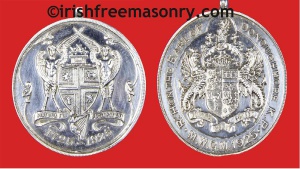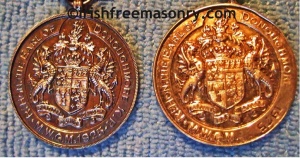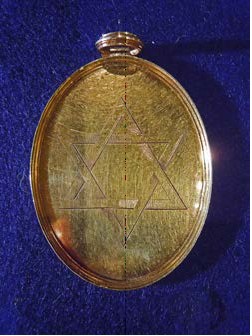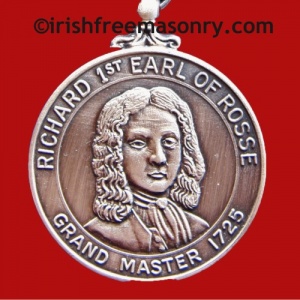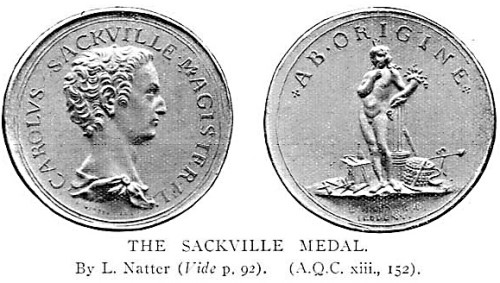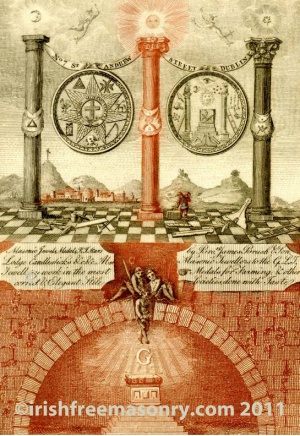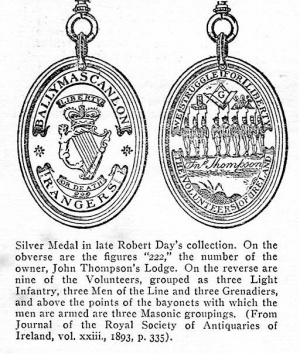En: Irish masonic medals: Unterschied zwischen den Versionen
Keine Bearbeitungszusammenfassung |
KKeine Bearbeitungszusammenfassung |
||
| (21 dazwischenliegende Versionen von 3 Benutzern werden nicht angezeigt) | |||
| Zeile 1: | Zeile 1: | ||
[[Datei:Medal.jpg|thumb|300px]] | |||
[[Datei:Rosse.jpg|thumb|300px]] | |||
[[Datei:Sackville.jpg]] | |||
[[Datei:Urk.jpg|thumb|300px]] | |||
[[Datei:Columns.jpg|thumb|300px|The Craft face has two Corinthian columns adorned with pomegranates, the blazing sun with sixteen flames, an open book bearing the square and compasses, standing on a dais of three steps: above a crescent moon and a | |||
group of seven stars, surmounted by an irradiated eye. On the left are a maul, trowel, gauge and a sprig of acacia: and on the right three candlesticks | |||
a hand holding a poniard and a ladder of three rungs leaning against one of | |||
the columns. Below in exergue the square, level and plumbrule with the signature “BRUSH”.]] | |||
[[Datei:Royal Arch.jpg|thumb|300px|The Royal Arch face has an arch lacking a keystone supported by an arcade of Corinthian columns. Within the arch is an altar of six steps with a breastplate and ewer at the sides, and above the letter “G” between three | |||
crowns: through the broken arch a hand appears and above it the blazing sun among clouds. Within the arcading, on the left is a burning bush, rod and serpent: on the right a kneeling figure holding up the tables of the law, interlaced triangles below. At the base a scroll is lying: and near the edge is | |||
the signature “BRUSH”.]] | |||
== Irish masonic medals == | == Irish masonic medals == | ||
| Zeile 4: | Zeile 21: | ||
Some of the most interesting artefacts associated with Irish Freemasonry are the various medals struck to commemorate special events in the history of our Masonic Lodges. Here we have details of a number of examples which were issued by Lodges under the Irish Constitution. | Some of the most interesting artefacts associated with Irish Freemasonry are the various medals struck to commemorate special events in the history of our Masonic Lodges. Here we have details of a number of examples which were issued by Lodges under the Irish Constitution. | ||
Source: [http://www.irishfreemasonry.com/index.php?p=1_20_Medals Irish Masonry] | '''Source: [http://www.irishfreemasonry.com/index.php?p=1_20_Medals Irish Masonry]''' | ||
== MEDALS OF THE IRISH CRAFT == | == MEDALS OF THE IRISH CRAFT == | ||
| Zeile 13: | Zeile 30: | ||
collection and classification of Irish Masonic Medals and to provide examples of same with some details of their purpose, design and distribution. | collection and classification of Irish Masonic Medals and to provide examples of same with some details of their purpose, design and distribution. | ||
=== Medal === | |||
Piece of metal, usually in the form of a coin, struck or cast with | Piece of metal, usually in the form of a coin, struck or cast with | ||
an inscription, armorial illustration or device to commemorate an anniversary or event. Produced to order, by many companies including The Royal Mint, they cannot be used as coin of the realm. Larger medals go under the name of Medallions. In Craft Lodges we normally see medals used to show membership of a particular Lodge, commemorate the foundation of a Lodge, a special event in its history or the achievement of a significant anniversary. Medals are also issued to commemorate the opening of new buildings and occasionally personalities. | an inscription, armorial illustration or device to commemorate an anniversary or event. Produced to order, by many companies including The Royal Mint, they cannot be used as coin of the realm. Larger medals go under the name of Medallions. In Craft Lodges we normally see medals used to show membership of a particular Lodge, commemorate the foundation of a Lodge, a special event in its history or the achievement of a significant anniversary. Medals are also issued to commemorate the opening of new buildings and occasionally personalities. | ||
== Medals in the Early Days == | === Medals in the Early Days === | ||
The first references to Masonic medals in the Irish Constitution date from the earliest surviving records of Irish Craft Masonry, which are to be found in the columns of “The Dublin Weekly Journal” for the 26th June 1725. Most of you will know that this is the first written record ( so far found ) of the existence of The Grand Lodge of Ireland and details the Installation of “The Earl of Rosse” as Grand Master for the ensuing year. | The first references to Masonic medals in the Irish Constitution date from the earliest surviving records of Irish Craft Masonry, which are to be found in the columns of “The Dublin Weekly Journal” for the 26th June 1725. Most of you will know that this is the first written record ( so far found ) of the existence of The Grand Lodge of Ireland and details the Installation of “The Earl of Rosse” as Grand Master for the ensuing year. | ||
Our interest in this event stems from one part of the newspaper report which reads as follows : | Our interest in this event stems from one part of the newspaper report which reads as follows : | ||
'' | |||
“ The Brothers of one Lodge wore fine badges painted full of crosses and | ''“ The Brothers of one Lodge wore fine badges painted full of crosses and | ||
squares, with this motto – Spes Mea in Deo Est.”'' | squares, with this motto – Spes Mea in Deo Est.”'' | ||
This medal comprises the portrait of the Earl of Rosse, Grand Master on | This medal comprises the portrait of the Earl of Rosse, Grand Master on | ||
the obverse with the dates 1725 – 2000, and on the reverse, the coat of arms | the obverse with the dates 1725 – 2000, and on the reverse, the coat of arms | ||
| Zeile 41: | Zeile 55: | ||
Irish Freemasonry Vol 5 ) both clearly confirm that this is the earliest known Irish Masonic medal. | Irish Freemasonry Vol 5 ) both clearly confirm that this is the earliest known Irish Masonic medal. | ||
The medal has a bust of [[Charles Sackville]], Earl of Middlesex with his head to the right. Hair short. Mantel fastened on right shoulder with a brooch. Legend “CAROLVS SACKVILLE MAGISTER.FL” ( [[Charles Sackville]] Master Florence ). Under the bust is the signature “ L.N. 1733 ” which stands for L.Natter a medallist born at Biberach, Suabia in 1705, and eventually died in St Petersburg in 1767. Natter is said to have taken the Rite | |||
The medal has a bust of Charles Sackville, Earl of Middlesex with his head to the right. Hair short. Mantel fastened on right shoulder with a brooch. Legend “CAROLVS SACKVILLE MAGISTER.FL” ( Charles Sackville Master Florence ). Under the bust is the signature “ L.N. 1733 ” which stands for L.Natter a medallist born at Biberach, Suabia in 1705, and eventually died in St Petersburg in 1767. Natter is said to have taken the Rite | |||
of Strict Observance from the city of Stockholm to St Petersburg. | of Strict Observance from the city of Stockholm to St Petersburg. | ||
| Zeile 67: | Zeile 79: | ||
and John Pennell – Grand Secretary and author of our first book of Irish Constitutions. | and John Pennell – Grand Secretary and author of our first book of Irish Constitutions. | ||
[[Datei: | Bro James Brush, Sen ( 1774-1812 ), a Dublin jeweller and engraver was one of the first Masonic manufacturers. His premises were located at 7 St Andrews Street, and he was treasurer of Royal Arch Lodge No 190. In 1792 | ||
he played a leading part in the establishment of a society for the relief and support of the orphan children of distressed Masons, formed by the members | |||
of Lodge 190. This society was adopted by Grand Lodge in 1798 and went | |||
on to become the Masonic Female Orphans School. As a result of his earlier work, Bro Brush was appointed first Treasurer of the new Grand Lodge School. | |||
Bro Brush developed a standard medal which had Craft symbols on one face and could have either Royal Arch or High Knight Templar symbolism on the other. These medals became quite popular at the time and a number of them survive to this day. | |||
==Gallery== | |||
[[Datei:Inhoc.jpg|thumb|300px|right|The High Knight Templar face has a seven pointed star thereon having a Christian cross in the centre, with the motto “IN HOC SIGNO VINCES” | |||
( In this sign we conquer ) within two concentric circles around. Mounted on the circles is a skull resting on crossed bones. In the spaces between the arms of the star are a series of symbols such as the paschal lamb, the cross pattee, triangle with twelve burning tapers, the cockerel, the hourglass, the coffin and the scythe. Below the whole is the signature “BRUSH”.]] | |||
[[Datei:Mossop.jpg|thumb|300px|left|The next Irish medallist that we shall consider in this paper is [[William Mossop]] Sen ( 1751 -1805 ) who made one outstanding medal for Irish Freemasonry. This medal, known as “The Prince Masons Medal” was originally produced as a prize medal by the Masonic Female Orphans School in Dublin in the year 1799. | |||
The obverse has a female figure surrounded by three children seated on a cross and anchor representing Faith, Hope & Charity. In exergue, on the left | |||
in very small writing the name “MOSSOP.F” | |||
On the reverse are the square and compasses, crossed enclosing an equilateral triangle on which is the letter “G” ; to the lower angle of the square is suspended an interlaced double triangle forming a six pointed star : above is a radiant All Seeing Eye. The medal is oval shaped size 64mm x 52mm usually found in bronze. Occasionally it is found with a loop for a ring which was attached to the planchet of some. | |||
This medal was designed by the celebrated Irish sculptor Smyth. The original wax impression was once in the possession of a Doctor William Frazer of Dublin, who presented it to The Royal Dublin Society in the early 1900’s. ]] | |||
[[Datei:Ozier.jpg|thumb|300px|Other unusual Irish medals on show in the museum include the Ozier medal dating from the year 1763. This medal, in gold was presented to Francis Ozier and has the number 2, referring to Lodge 2 Dublin. The | |||
obverse of the medal shows the figure of a Master, holding a drawing or plan, standing on a mosaic pavement, between two pillars, each capped with a globe ( terrestrial & celestial), above is the “All Seeing Eye” and the legend “Sapienta”. On the left, outside of the column are the compasses, plumbrule and level. On the right outside the column is the outline of a Temple. The reverse of the medal has as a centrepiece the Volume of the Sacred Law resting on the 24” gauge with the level and plumbrule on either side. On the top of the volume of the sacred law is a set of compasses resting on a square and the whole has the All Seeing Eye on top with the legend “Sit Lux Et Lux Fuit ( Let there be Light and there was Light ). Below the 24”gauge are a ladder with three rungs and the Pythagorean proposition. This jewel is | |||
illustrated in the 1927 Transactions of the Lodge of Research along with similar examples presented to Bro John Campbell in 1773 by the Members of Lodge 489, Dublin and to Bro David Colhoun in 1802 by the Members of Lodge 547, Newtownstewart. These fine jewels can all be seen in the '''Grand Lodge collections in Molesworth Street.''']] | |||
[[Datei:Sun.jpg|thumb|300px|left|Another uniquely Irish medal is the Minden medal struck in 1848 by the Members of The Minden Lodge, an Irish travelling warrant attached to the 26th Regiment of Foot ( Cameronians ) sometimes known as the Scottish Rifles. This Lodge decided to strike a centenary medal to commemorate the issue of their original Irish warrant ( No 309 ) which was issued to Lord George Sackville, Colonel Edward Cornwallis and a Captain Milbourne on the 7th December 1748. Lord George Sackville was a younger brother to Charles, the Earl of Middlesex, whose medal was previously described. So the Brethren of Minden determined that their medal should be given | |||
to all twenty members of the Lodge, and after much consideration they decided to adopt a wooden wheel as their background with the name of one of their members on all sixteen of the staves. The centrepiece of the design was an “All Seeing Eye” with a circular hub around and on this hub was the legend “C. South. PM and WM Elect”. From this hub emanated sixteen separate staves and on each stave was the name of a Lodge member :- “M. Kane, D. Bilham, P. Gerachtys, T. McMullan, T. Peden, J. Clarke, J. Matherson, J.D.G. Kilhourn, J Balme, H. Gibson, T.J. Waring, I.G.T. Higgins, W. Harris, J. Shaddock, R. Perkins and J. McGee.” On the outer band of the wheel were the three final Lodge Officers :- “ F. Oliver WM” | |||
at the top, “W. Robertson JW” on the right and “J. Clarke SW” on the left. | |||
This medal can claim to be the first Centenary Medal in the Irish Constitution. It was issued just one year ahead of The Grand Master’s Lodge, which was not issued until 1849. Over the preceding one hundred years the Minden Lodge, had survived many tribulations in postings across the British Empire of the day. All of its Lodge records up until the year 1802 have been lost as a result of these travails. In 1823, Lodge 309 applied to Grand Lodge to change its Warrant for a higher number, and was issued No 26, tying in with its honourable position on the roll of foot regiments within the British Army. The Lodge continued to work right up to the start of the First World War in 1914. However on the bloody fields of France the regiment was decimated losing most of its Officers, NCO’s and men. The Lodge never recovered and the Warrant was returned to Grand Lodge in 1922.]] | |||
[[Datei:Grand.jpg|thumb|300px|As previously mentioned “The Grand Master’s Lodge” celebrated its | |||
Centenary in 1849, when it too issued a centenary medal. The Lodge was first Warranted in 1749 by the Lord Kingsborough as a personal Lodge for | |||
his Lordship and his Grand Lodge officers. It was a Lodge unique to the | |||
Irish Constitution and for many years up to the 1820’s it had the sole right to nominate the officers of The Grand Lodge of Ireland. It was not until 1780 that Lawrence Dermott as Grand Secretary of The Grand Lodge of the Antients and a past Master of Lodge 26 Sligo introduced a similar Lodge into the English Constitutions. The medal itself comprises :- | |||
Obverse :- A man standing full face, holding in his right hand a pair of extended compasses and in his left a trowel; he wears the hat, collar, jewel and gauntlets of a Master, and an apron bearing the letters G.M.L. on the fall. At the right is a pedestal having on the front a panel, on which is a pentalpha; on the ground to the left are a gavel and chisel, in front a sword with the hilt to the left and to the right a plumb, level, square 24” gauge and protractor leaning against a rough ashler. Near the edge, to the right is a sprig of acacia, and ruins in the distance. Below the tools are the small letters H.E.F. . To the left is part of a Temple. Over all is a radiant “All Seeing Eye”. Above the legend “GRAND MASTER’S LODGE” and below “CENTENARY 3D JANUARY 5849”. Reverse :- Legend in seven lines “ THE MOST NOBLE / AUGUSTUS | |||
FREDERICK / DUKE OF LEINSTER / GRAND MASTER OF THE / | |||
ORDER OF FREE AND / ACCEPTED MASONS / OF IRELAND”.]] | |||
Finally Brethren, I will make passing reference to that exciting period of Irish history when Freemasonry became entwined with the politics of the day and was seen as an important aspect of the 1770-1796 Volunteer Movement. It was at the famous Dungannon Volunteer Convention we first hear the phrase that every Volunteer Battalion should have its own Masonic Lodge and that every Masonic Lodge should set up its own Volunteer Battalion. The whole story of the Volunteer Movement in Ireland covers a fascinating period of Irish history from the latter part of the eighteenth century. It is the story of a struggle for economic and political freedom from repressive government and the Masonic Order were seen to be in the vanguard of this struggle. | |||
[[Datei:Buckle1.jpg]] | |||
From the medallic point of view there are two well known Masonic artefacts with strong links to this period in history. One is the copper-plate buckle worn by the serving members of the Lowtherstown Masonick Volunteers which couples the usual volunteer symbol of Hibernia and her harp with a number of Masonic symbols including the Holy Royal Arch complete with keystone, the sacred letter “G”, the third degree compasses and square, the three steps up to ( in this case Hibernia stands in lieu of the Altar ), the plumbline, the cockerel and a representation of the Sun in splendour, representative of ( in this instance ) the light of Freedom. Lowtherstown was of course the old name for Irvinestown, in Co Fermanagh and the main man in this Battalion, was William Irvine, who at that time had | |||
the title of Provincial Grand Master of Ulster, which would have made him the senior freemason in the province of Ulster at that time. | |||
[[Datei:Buckle2.jpg|300px|left]] | |||
[[Datei:Red.jpg|thumb|300px|left|Probably the best known Centenary medal was the medal issued on the 4th June 1925 to commemorate the bi-centenary of the Grand Lodge of Ireland 1725-1925. This medal consisted of the coat of arms of the Grand Lodge of Ireland on the obverse and the coat of arms of the Rt Hon the Earl of Donoughmore KP, Most Wor Grand Master of the Most Wor the Grand Lodge of Ireland on the reverse. The medal has a silver bar giving the date 4th June 1925 and Brethren who | |||
attended the bi-centenary service in Christchurch Cathedral on the day were entitled to wear the bar. Indeed, a special commemorative silver and enamel brooch bearing the date 4th June 1925 was struck and issued to all 20 Brethren who acted as stewards within the Cathedral precincts on the 4th June 1925.]] | |||
[[Datei:Donough.jpg|thumb|300px|In 1975 the jewellers West & Sons of Dublin, who struck the original dies for the 1925 jewel, produced at their own expense a restrike version of the 1725-1925 jewel with the 2 in 1925 changed to a 7 to read 1975 and issued these jewels, in silver to all serving Grand Lodge Officers in the year 1975. So Brethren, if you happen to see an Irish bi-centenary jewel in an auction or a dealers cabinet, check the dates very carefully, as you may be fortunate enough to find a very rare Irish medal indeed. | |||
Brethren, these are a few of the medals associated with the Irish Constitution, and as this site grows, we hope to add more examples to this section as new photographs and details come to hand.]] | |||
== See also == | |||
*[[Charles Sackville]] | |||
[[Kategorie:Art|Irishmedals]] | |||
Aktuelle Version vom 22. Januar 2019, 12:48 Uhr
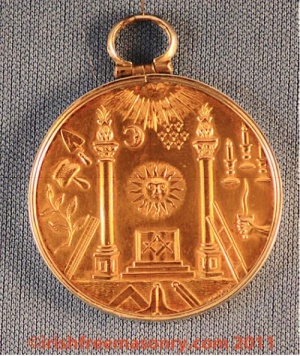

Irish masonic medals
Some of the most interesting artefacts associated with Irish Freemasonry are the various medals struck to commemorate special events in the history of our Masonic Lodges. Here we have details of a number of examples which were issued by Lodges under the Irish Constitution.
Source: Irish Masonry
MEDALS OF THE IRISH CRAFT
Introduction
It is my intention in this short address to place on record my thoughts on the collection and classification of Irish Masonic Medals and to provide examples of same with some details of their purpose, design and distribution.
Medal
Piece of metal, usually in the form of a coin, struck or cast with an inscription, armorial illustration or device to commemorate an anniversary or event. Produced to order, by many companies including The Royal Mint, they cannot be used as coin of the realm. Larger medals go under the name of Medallions. In Craft Lodges we normally see medals used to show membership of a particular Lodge, commemorate the foundation of a Lodge, a special event in its history or the achievement of a significant anniversary. Medals are also issued to commemorate the opening of new buildings and occasionally personalities.
Medals in the Early Days
The first references to Masonic medals in the Irish Constitution date from the earliest surviving records of Irish Craft Masonry, which are to be found in the columns of “The Dublin Weekly Journal” for the 26th June 1725. Most of you will know that this is the first written record ( so far found ) of the existence of The Grand Lodge of Ireland and details the Installation of “The Earl of Rosse” as Grand Master for the ensuing year. Our interest in this event stems from one part of the newspaper report which reads as follows :
“ The Brothers of one Lodge wore fine badges painted full of crosses and squares, with this motto – Spes Mea in Deo Est.”
This medal comprises the portrait of the Earl of Rosse, Grand Master on the obverse with the dates 1725 – 2000, and on the reverse, the coat of arms of the Grand Lodge of Ireland. The medal was manufactured in silver or with an antique bronze finish and was suspended on a white ribbon with a red St Patrick’s Cross emblazoned thereon, or alternatively it could be purchased as a medalet in an antique bronze finish. The silver jewels, five hundred in total were individually numbered and have the millennium assay stamp from Dublin for the year 2000. I was fortunate to acquire No 280, the number of my Mother Lodge.]]
I wonder how many of you recognise the motto – “My Hope is in God”. However this written report is indisputably the first record of medals being worn at a Masonic meeting. Many of you will know that this event was commemorated by Grand Lodge with the issue of a medal in the year 2000 to commemorate the 275th anniversary of the investiture of our first recorded Grand Master.
Sadly, our next piece – The Sackville medal is not so plentiful. Struck in 1733, the Sackville medal has been the cause of much debate over the years as to its authenticity. However independent research carried out at the end of the 19th century by Bro W Begemann for his paper published in AQC (Volume 12 page 204) and Rt Wor Bro Chetwode Crawley, LLD ( Notes on Irish Freemasonry Vol 5 ) both clearly confirm that this is the earliest known Irish Masonic medal.
The medal has a bust of Charles Sackville, Earl of Middlesex with his head to the right. Hair short. Mantel fastened on right shoulder with a brooch. Legend “CAROLVS SACKVILLE MAGISTER.FL” ( Charles Sackville Master Florence ). Under the bust is the signature “ L.N. 1733 ” which stands for L.Natter a medallist born at Biberach, Suabia in 1705, and eventually died in St Petersburg in 1767. Natter is said to have taken the Rite of Strict Observance from the city of Stockholm to St Petersburg.
On the reverse of the medal is the figure of Hippocrates, the God of Silence, leaning upon a broken fluted column, on his head are some lotus or laurel leaves; in his left hand is a cornucopia : at his feet to the left, is a perfect ashlar on which a hammer and gavel are lying : against its side a plumb, rule and square are resting: on the ground are a pair of compasses, the 24 inch gauge and some chisels crossed saltireways: to his left a coil Of rope, and leaning against it, a pick and serpent: in the rear are some tools, which are difficult to decipher. In exergue, in two lines “L. NATTER. F./ FLORENT” ( L. Natter Fecit (made) Florence ). “AB ORIGINE” ( In the Beginning. This is a fascinating medal struck to commemorate the foundation of an Irish Lodge in Florence by Charles Sackville. We know that Charles Sackville was born in 1711, the eldest son of Lionel Cranfield Sackville 7th Earl and 1st Duke of Dorset. Charles held the title of Lord Buckhurst until 1720, when as a result of his fathers Dukedom, he became Earl of Middlesex. On the death of his father in 1765 he became the second Duke of Dorset.
It is a matter of record that Charles Sackville was too young to be an English Mason in 1733, as the minimum age for entry in England, at that time was 25. Extensive checks of English Grand Lodge records can find no mention of the Earl of Middlesex.
The story in Ireland is somewhat different. One only had to be 21 to become an Irish Mason. The Sackville family have had a long involvement with Ireland over the years. In 1731 his father Cranfield was appointed Viceroy and it took his Grace three weeks to travel from London to Dublin with his father. Charles was entered into Trinity College, Dublin where he studied for a short time, before going on to Christ Church in Oxford. It is a matter of record that Charles went to Florence in October 1732. He found the place so pleasant that he extended his visit until June 1733, before rushing home to accompany his father back to Dublin. This time round they made the trip in 13 days. In those days Dublin was further from London than Australia is today.
Finally we can show that the Earl of Middlesex was a keen Irish Mason in that he had no sooner returned to Dublin than he attended a Meeting of the Grand Lodge of Ireland, and his visit was recorded in the Faulkner’s Dublin Journal for Saturday the 24th November 1733. On that occasion the Lord Viscount Kingsland, Grand Master was in the chair. Others present on that occasion included Thomas Griffith the comic actor and past Grand Secretary and John Pennell – Grand Secretary and author of our first book of Irish Constitutions.
Bro James Brush, Sen ( 1774-1812 ), a Dublin jeweller and engraver was one of the first Masonic manufacturers. His premises were located at 7 St Andrews Street, and he was treasurer of Royal Arch Lodge No 190. In 1792 he played a leading part in the establishment of a society for the relief and support of the orphan children of distressed Masons, formed by the members of Lodge 190. This society was adopted by Grand Lodge in 1798 and went on to become the Masonic Female Orphans School. As a result of his earlier work, Bro Brush was appointed first Treasurer of the new Grand Lodge School. Bro Brush developed a standard medal which had Craft symbols on one face and could have either Royal Arch or High Knight Templar symbolism on the other. These medals became quite popular at the time and a number of them survive to this day.
Gallery
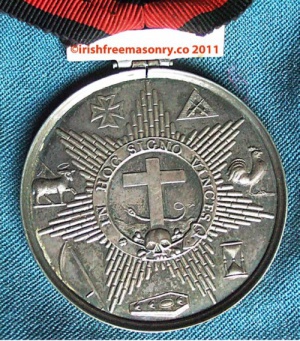

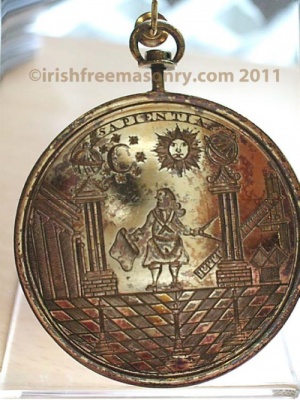
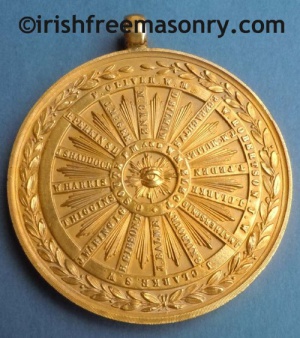

Finally Brethren, I will make passing reference to that exciting period of Irish history when Freemasonry became entwined with the politics of the day and was seen as an important aspect of the 1770-1796 Volunteer Movement. It was at the famous Dungannon Volunteer Convention we first hear the phrase that every Volunteer Battalion should have its own Masonic Lodge and that every Masonic Lodge should set up its own Volunteer Battalion. The whole story of the Volunteer Movement in Ireland covers a fascinating period of Irish history from the latter part of the eighteenth century. It is the story of a struggle for economic and political freedom from repressive government and the Masonic Order were seen to be in the vanguard of this struggle.
From the medallic point of view there are two well known Masonic artefacts with strong links to this period in history. One is the copper-plate buckle worn by the serving members of the Lowtherstown Masonick Volunteers which couples the usual volunteer symbol of Hibernia and her harp with a number of Masonic symbols including the Holy Royal Arch complete with keystone, the sacred letter “G”, the third degree compasses and square, the three steps up to ( in this case Hibernia stands in lieu of the Altar ), the plumbline, the cockerel and a representation of the Sun in splendour, representative of ( in this instance ) the light of Freedom. Lowtherstown was of course the old name for Irvinestown, in Co Fermanagh and the main man in this Battalion, was William Irvine, who at that time had the title of Provincial Grand Master of Ulster, which would have made him the senior freemason in the province of Ulster at that time.
